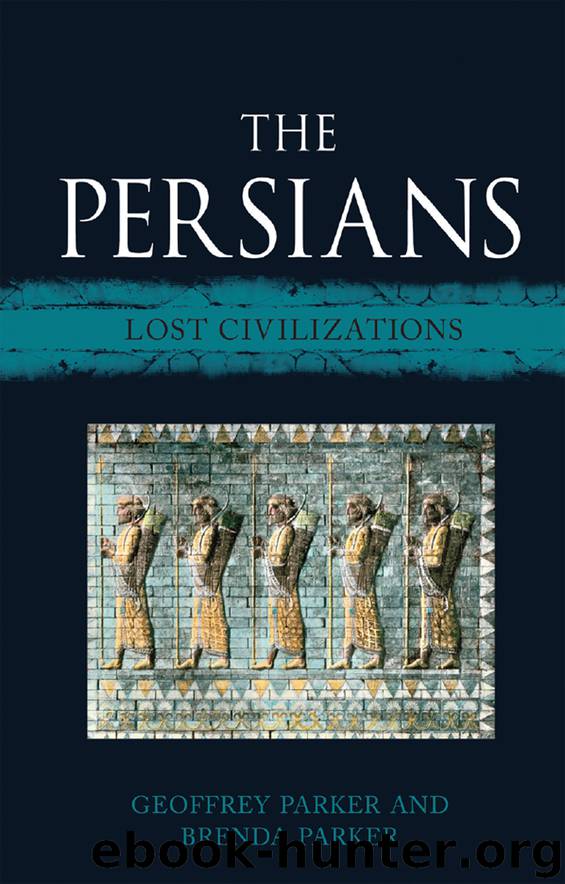The Persians by Geoffrey Parker

Author:Geoffrey Parker
Language: eng
Format: epub
Publisher: Reaktion Books
ELEVEN
FROM PERSEPOLIS TO SAMARKAND: THE PERSIAN LEGACY IN CENTRAL ASIA
The territory of Persia and its successive empires centred on the Middle East, a region which is, of course, contiguous with other parts of Asia. As a consequence of its proximity to both Central and South Asia, historically Persia has influenced, and been influenced by, the peoples of these regions. In the millennium following the fall of the Achaemenid Empire and its Hellenistic successor states, there were numerous invasions from Central Asia by Parthians, Turks and Mongols, all of whom conquered large parts of the Middle East and established powerful empires there. All of them incorporated the lands that had been part of the Achaemenid and Sasanid empires and their centres of power were also inherited from those earlier rulers. These incomers were inevitably influenced by the indigenous civilization of the lands they conquered.
In addition to this, over time Persia came to exercise considerable influence over adjacent Central Asia, and this was nowhere more in evidence than in the lands between the Caspian and the Aral seas. This influence was of crucial importance in changing this region from one dominated by nomadic pastoralists – ‘barbarians’ in Greek terms – to one of the few great civilizations to develop in the heart of Asia itself. From the very beginning, in the time of the Achaemenids, the Persians had sought to bring Central Asia into their sphere. It was from there that the Persians and their mentors the Medes had first come, and they were followed by many other migrants seeking the better life which they believed was to be found in the lands to the south. As a result, the Central Asian lands were always considered a danger and from the outset of their imperial venture the Persians sought to prevent more unwelcome immigrants from descending on their empire and disrupting their rule.1 Persistent Persian interventions meant that over the centuries the adjacent parts of Central Asia became gradually more integrated politically, economically and culturally with Persia itself.
During the reign of Darius the Great, the Achaemenid Empire extended its control deep into Central Asia and at that time the whole of Transoxiana was brought under the rule of the Great King. During that reign the region was divided into satrapies for administrative purposes and a Persian governing class was established there. Similarly, under the Sasanids, and later the Arabs, there was further penetration into the region. With the Arab invasions, Islam also took hold and this was to prove of great significance in the transformation of the Islamic world in later centuries.
Economically, Transoxiana in particular was a most welcome addition to any empire. The great trading cities of Samarkand, Bukhara and Balkh were of considerable commercial importance, adding a great deal to the economic power of the state within which they were located. One of the main reasons for this was that they lay on the Silk Road, that great trading route stretching across Asia from Europe to China. While the two
Download
This site does not store any files on its server. We only index and link to content provided by other sites. Please contact the content providers to delete copyright contents if any and email us, we'll remove relevant links or contents immediately.
| Africa | Americas |
| Arctic & Antarctica | Asia |
| Australia & Oceania | Europe |
| Middle East | Russia |
| United States | World |
| Ancient Civilizations | Military |
| Historical Study & Educational Resources |
Empire of the Sikhs by Patwant Singh(23020)
The Wind in My Hair by Masih Alinejad(5056)
Rise and Kill First by Ronen Bergman(4739)
The Templars by Dan Jones(4656)
The Rape of Nanking by Iris Chang(4165)
12 Strong by Doug Stanton(3525)
Blood and Sand by Alex Von Tunzelmann(3164)
Babylon's Ark by Lawrence Anthony(2648)
The History of Jihad: From Muhammad to ISIS by Spencer Robert(2599)
No Room for Small Dreams by Shimon Peres(2343)
The Turkish Psychedelic Explosion by Daniel Spicer(2330)
Inside the Middle East by Avi Melamed(2325)
Gideon's Spies: The Secret History of the Mossad by Gordon Thomas(2319)
Arabs by Eugene Rogan(2279)
The First Muslim The Story of Muhammad by Lesley Hazleton(2245)
Come, Tell Me How You Live by Mallowan Agatha Christie(2228)
Bus on Jaffa Road by Mike Kelly(2123)
Kabul 1841-42: Battle Story by Edmund Yorke(2003)
1453 by Roger Crowley(1994)
